Nacos high availability environment construction
Nacos highly available environment = Nacos cluster + Nacos persistence

Reference: < ( ̄)  ̄) ↗ Nacos official website - cluster deployment instructions
@
1. Create Docker LAN
-
Create Docker LAN
PS C:\Users\xiao> docker network create MyNetwork 56b64b706d69bf2d3b30eb6d63c94bb110c74e16febf96c1b1b0aa687cc3d493
-
List all LANs
PS C:\Users\xiao> docker network ls NETWORK ID NAME DRIVER SCOPE 56b64b706d69 MyNetwork bridge local e19f31ab243a bridge bridge local 09b9f7e52530 host host local 3bb55566e6c5 none null local
-
View LAN details
PS C:\Users\xiao> docker network inspect MyNetwork [ { "Name": "MyNetwork", "Id": "56b64b706d69bf2d3b30eb6d63c94bb110c74e16febf96c1b1b0aa687cc3d493", "Created": "2022-01-27T11:58:16.195894307Z", "Scope": "local", "Driver": "bridge", "EnableIPv6": false, "IPAM": { "Driver": "default", "Options": {}, "Config": [ { "Subnet": "172.18.0.0/16", "Gateway": "172.18.0.1" } ] }, "Internal": false, "Attachable": false, "Ingress": false, "ConfigFrom": { "Network": "" }, "ConfigOnly": false, "Containers": {}, "Options": {}, "Labels": {} } ]
2. Create and start an Nginx container and join the container to the LAN
-
Create and start the Nginx container
-
Join Nginx container to LAN
PS C:\Users\xiao> docker network connect MyNetwork MyNginx
-
Check whether the Nginx container has successfully joined the LAN
PS C:\Users\xiao> docker network inspect MyNetwork [ { "Name": "MyNetwork", "Id": "56b64b706d69bf2d3b30eb6d63c94bb110c74e16febf96c1b1b0aa687cc3d493", "Created": "2022-01-27T11:58:16.195894307Z", "Scope": "local", "Driver": "bridge", "EnableIPv6": false, "IPAM": { "Driver": "default", "Options": {}, "Config": [ { "Subnet": "172.18.0.0/16", "Gateway": "172.18.0.1" } ] }, "Internal": false, "Attachable": false, "Ingress": false, "ConfigFrom": { "Network": "" }, "ConfigOnly": false, "Containers": { "9ba1cfa5e902ba3f4cfebb6404d03f8c4cbe1aa418fc4ae682722c5882c88811": { "Name": "MyNginx", "EndpointID": "22e350022928c6e597a0bc217b84270525ab8400bb84d04387d63632f0b028eb", "MacAddress": "02:42:ac:12:00:02", "IPv4Address": "172.18.0.2/16", "IPv6Address": "" } }, "Options": {}, "Labels": {} } ]
3. Create and start a MySQL container and add the container to the LAN
-
Create and start MySQL container
-
Join MySQL container to LAN
PS C:\Users\xiao> docker network connect MyNetwork MyMySQL
-
Check whether the MySQL container has successfully joined the LAN
PS C:\Users\xiao> docker network inspect MyNetwork [ { "Name": "MyNetwork", "Id": "56b64b706d69bf2d3b30eb6d63c94bb110c74e16febf96c1b1b0aa687cc3d493", "Created": "2022-01-27T11:58:16.195894307Z", "Scope": "local", "Driver": "bridge", "EnableIPv6": false, "IPAM": { "Driver": "default", "Options": {}, "Config": [ { "Subnet": "172.18.0.0/16", "Gateway": "172.18.0.1" } ] }, "Internal": false, "Attachable": false, "Ingress": false, "ConfigFrom": { "Network": "" }, "ConfigOnly": false, "Containers": { "9ba1cfa5e902ba3f4cfebb6404d03f8c4cbe1aa418fc4ae682722c5882c88811": { "Name": "MyNginx", "EndpointID": "22e350022928c6e597a0bc217b84270525ab8400bb84d04387d63632f0b028eb", "MacAddress": "02:42:ac:12:00:02", "IPv4Address": "172.18.0.2/16", "IPv6Address": "" }, "45a4bca256c29842067cb324c67f3288c24b545a61cb796f4df1bfc5b1fcaae6": { "Name": "MyMySQL", "EndpointID": "f80a9fbd1f849a58f18b45d4d7684295e6d8e593c0b308af7215846692e2e57d", "MacAddress": "02:42:ac:12:00:03", "IPv4Address": "172.18.0.3/16", "IPv6Address": "" } }, "Options": {}, "Labels": {} } ]
4. Create and start three Nacos containers and join them to the LAN
-
Create and start the Nacos container (cluster mode)
<( ̄︶ ̄)↗Nacos actual combat - installation and use md
docker run -itd -p 8848:8848 --env MODE=cluster --name MyNacos1 nacos/nacos-server docker run -itd -p 8849:8848 --env MODE=cluster --name MyNacos2 nacos/nacos-server docker run -itd -p 8850:8848 --env MODE=cluster --name MyNacos3 nacos/nacos-server
-
Join the Nacos container to the LAN
docker network connect MyNetwork MyNacos1 docker network connect MyNetwork MyNacos2 docker network connect MyNetwork MyNacos3
-
Check whether the Nacos container has successfully joined the LAN
PS C:\Users\xiao> docker network inspect MyNetwork [ { "Name": "MyNetwork", "Id": "56b64b706d69bf2d3b30eb6d63c94bb110c74e16febf96c1b1b0aa687cc3d493", "Created": "2022-01-27T11:58:16.195894307Z", "Scope": "local", "Driver": "bridge", "EnableIPv6": false, "IPAM": { "Driver": "default", "Options": {}, "Config": [ { "Subnet": "172.18.0.0/16", "Gateway": "172.18.0.1" } ] }, "Internal": false, "Attachable": false, "Ingress": false, "ConfigFrom": { "Network": "" }, "ConfigOnly": false, "Containers": { "9ba1cfa5e902ba3f4cfebb6404d03f8c4cbe1aa418fc4ae682722c5882c88811": { "Name": "MyNginx", "EndpointID": "22e350022928c6e597a0bc217b84270525ab8400bb84d04387d63632f0b028eb", "MacAddress": "02:42:ac:12:00:02", "IPv4Address": "172.18.0.2/16", "IPv6Address": "" }, "45a4bca256c29842067cb324c67f3288c24b545a61cb796f4df1bfc5b1fcaae6": { "Name": "MyMySQL", "EndpointID": "f80a9fbd1f849a58f18b45d4d7684295e6d8e593c0b308af7215846692e2e57d", "MacAddress": "02:42:ac:12:00:03", "IPv4Address": "172.18.0.3/16", "IPv6Address": "" }, "b2268309c7e072f7212fc10efc773636676243d40067e8f4511324786701aed7": { "Name": "MyNacos1", "EndpointID": "2d0c0db59c5918bac6955bdc24682576d0b8301ea67097110d5a4f6a8557966e", "MacAddress": "02:42:ac:12:00:04", "IPv4Address": "172.18.0.4/16", "IPv6Address": "" }, "a07e465b71cd19c54caa26aeb58aad9714d03945d029648ec65e61affc3b1796": { "Name": "MyNacos2", "EndpointID": "0a5a371b04e2eb4087836a817785edaf86a356b1ad100f164328d6481a17b190", "MacAddress": "02:42:ac:12:00:05", "IPv4Address": "172.18.0.5/16", "IPv6Address": "" }, "d29eceb1c4b5d6071a8e11d75dce038f27eae5e8800cafc7cbeb97429c3d5d95": { "Name": "MyNacos3", "EndpointID": "79cb067cd0d3c267fc51614fc794c31d8922e334132a3ae3efaabf4dd3bb7e60", "MacAddress": "02:42:ac:12:00:06", "IPv4Address": "172.18.0.6/16", "IPv6Address": "" } }, "Options": {}, "Labels": {} } ]
5. Verify whether the above containers can ping each other
Note: ping: command not found
Solution: apt get update + apt get iputils Ping
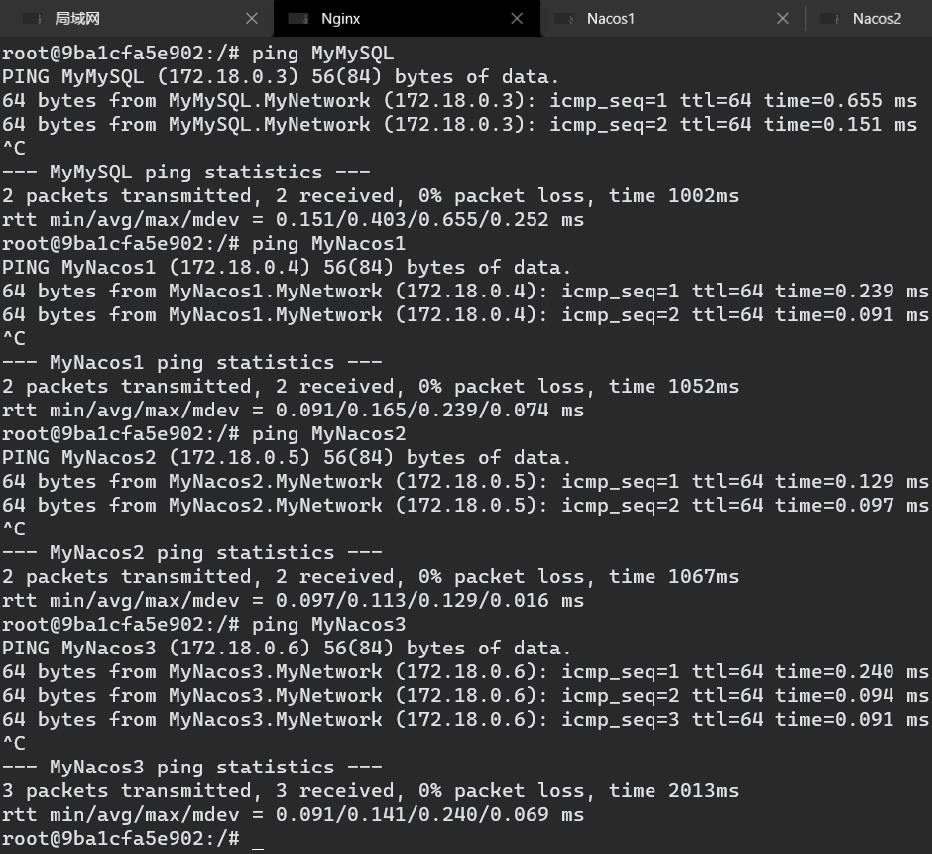
6. Configure Nacos persistence and cluster
<( ̄︶ ̄)↗Nacos actual combat - persistence md
-
Obtained from the official website of Nacos Nacos database build script , MySQL executes the script to build the Nacos database
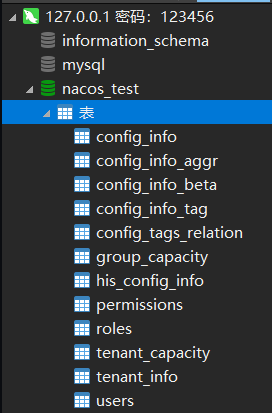
-
Enter the Nacos instance and modify / conf / application Properties file to configure Nacos persistence

-
Modify / conf / cluster Conf configuration file to configure the Nacos cluster

7. Verify that Nacos persistence is in effect
-
Restart all Nacos instances
-
Open the control panel of any Nacos instance and create several configuration information
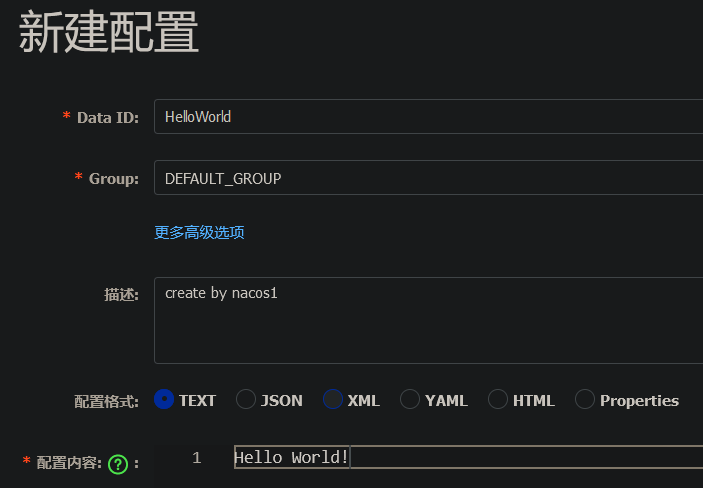
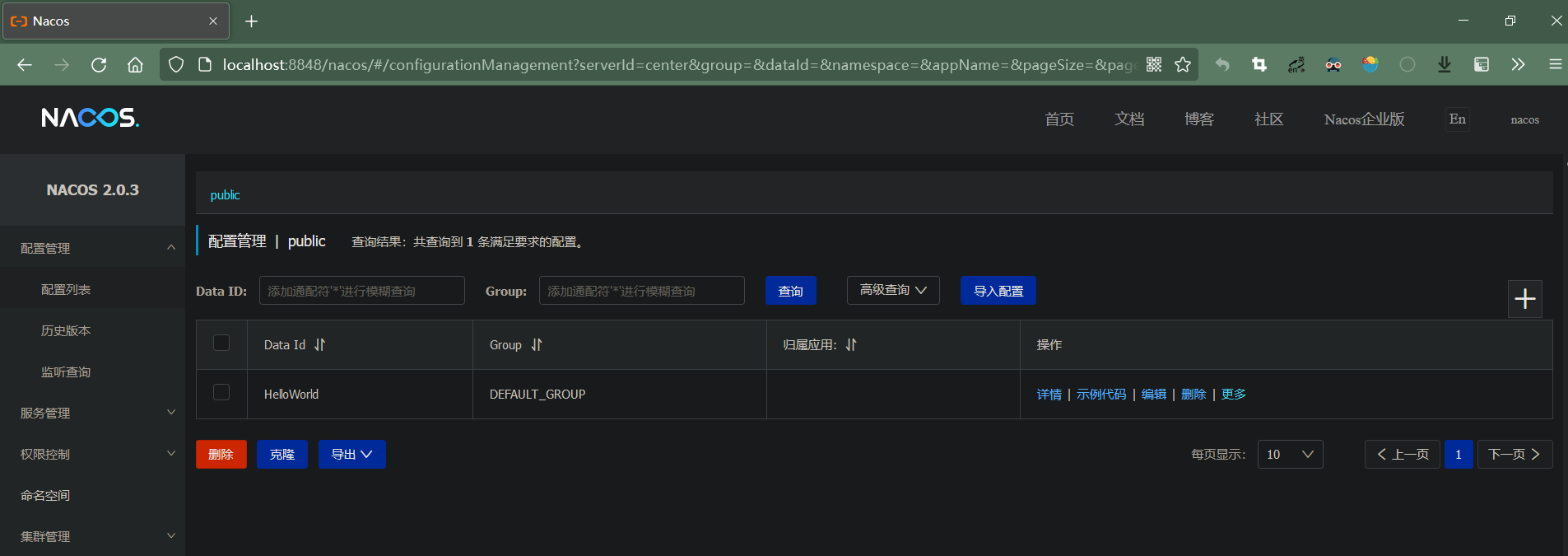
-
Check whether the configuration information is stored in the database


-
Open the control panel of other Nacos instances and check whether the same configuration information is obtained
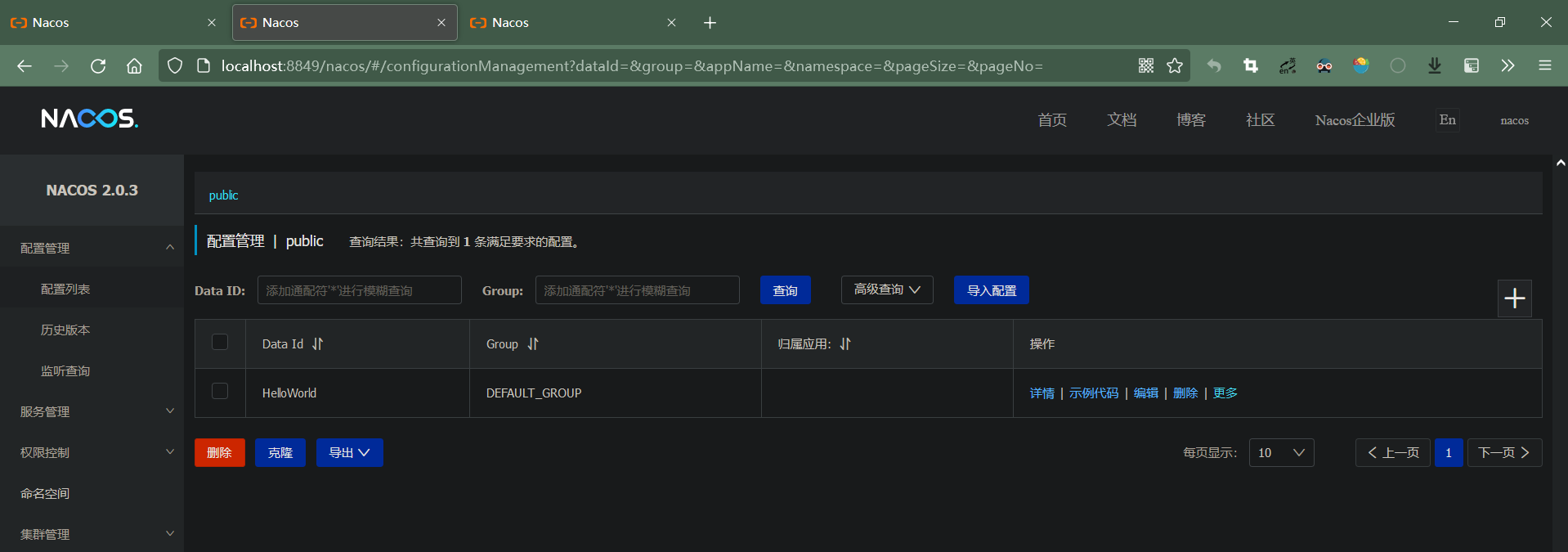
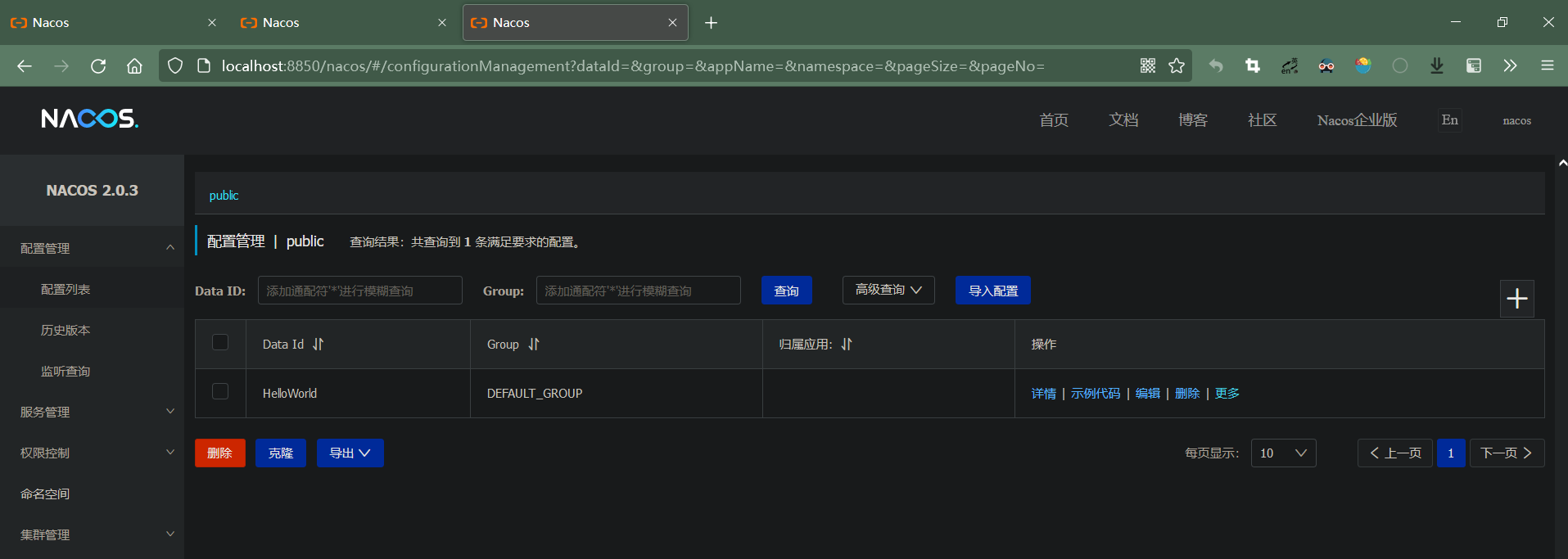
8. Configure Nginx load balancing for Nacos
<( ̄︶ ̄)↗
Enter the Nginx container and configure the custom configuration file / etc / Nginx / conf.d/nacosloadbalance conf
upstream serverInstance {
# ip_hash;
server 172.18.0.4:8848 weight=1;
server 172.18.0.5:8848 weight=1;
server 172.18.0.6:8848 weight=1;
}
server {
listen 80;
server_name 127.0.0.1;
location ~ /nacos/ {
proxy_pass http://serverInstance;
proxy_connect_timeout 10;
}
}
9. Verify that Nginx load balancing is in effect
-
Modify the Nginx configuration file and change the log format
log_format main '$remote_addr --"$request"--> $http_host--> $upstream_addr [$status $request_time]';
-
Restart Nginx
-
Access the Nacos control panel via Nginx
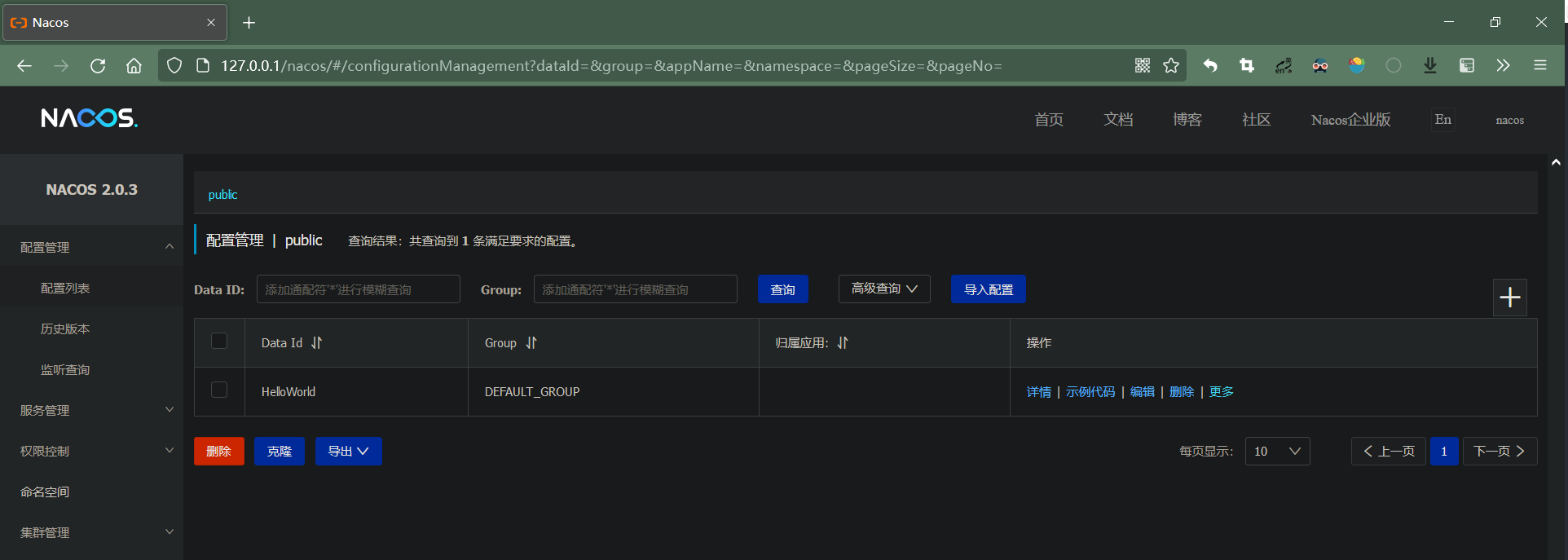
-
View the log file after several refreshes
172.18.0.1 --"GET /nacos/ HTTP/1.1"--> 127.0.0.1--> 172.18.0.4:8848 [200 0.012] 172.18.0.1 --"GET /nacos/ HTTP/1.1"--> 127.0.0.1--> 172.18.0.5:8848 [304 0.010] 172.18.0.1 --"GET /nacos/ HTTP/1.1"--> 127.0.0.1--> 172.18.0.6:8848 [304 0.009] 172.18.0.1 --"GET /nacos/ HTTP/1.1"--> 127.0.0.1--> 172.18.0.4:8848 [200 0.010] 172.18.0.1 --"GET /nacos/ HTTP/1.1"--> 127.0.0.1--> 172.18.0.5:8848 [200 0.010] 172.18.0.1 --"GET /nacos/ HTTP/1.1"--> 127.0.0.1--> 172.18.0.6:8848 [304 0.010]